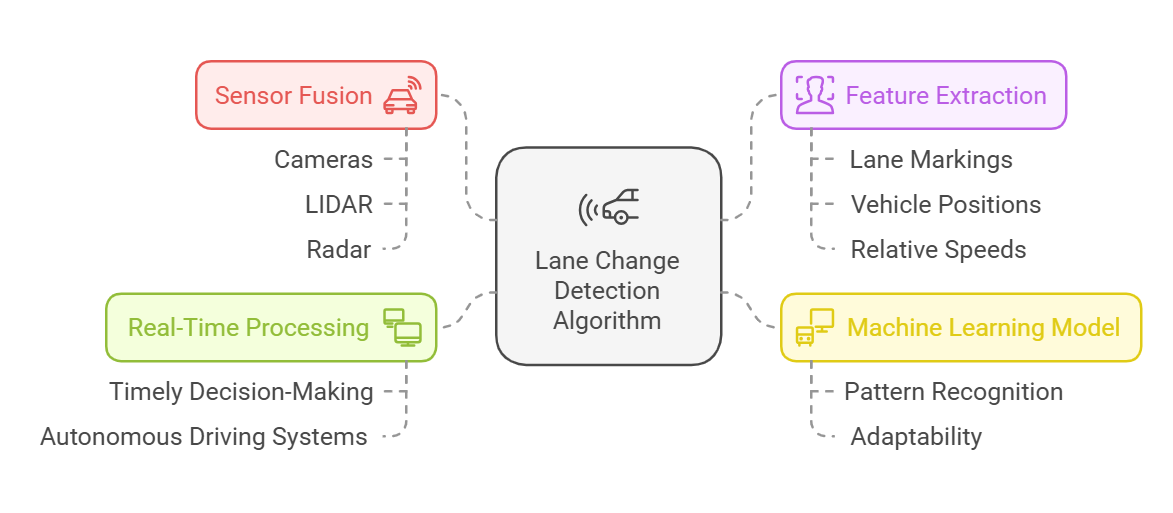Advanced Lane Change Detection Algorithm On Real World Driving For Arbitrary Road Infrastructures
This document presents an advanced lane change detection algorithm designed for real-world driving scenarios across various road infrastructures. The algorithm aims to enhance vehicle safety and navigation by accurately identifying lane changes in dynamic environments. By leveraging state-of-the-art machine learning techniques and sensor fusion, the proposed solution addresses the challenges posed by diverse road conditions and driver behaviors.
Introduction
Lane change detection is a critical component of advanced driver-assistance systems (ADAS) and autonomous vehicles. As vehicles navigate through complex road networks, the ability to accurately detect lane changes can significantly improve safety and traffic flow. This document outlines the development and implementation of an advanced algorithm that can operate effectively in arbitrary road infrastructures, taking into account various factors such as road markings, vehicle dynamics, and environmental conditions.
Algorithm Overview
The proposed lane change detection algorithm consists of several key components:
Sensor Fusion: The algorithm integrates data from multiple sensors, including cameras, LIDAR, and radar, to create a comprehensive understanding of the vehicle's surroundings. This multi-sensor approach enhances the robustness of lane change detection.
Feature Extraction: Using computer vision techniques, the algorithm extracts relevant features from the sensor data, such as lane markings, vehicle positions, and relative speeds. These features are crucial for determining whether a lane change is occurring.
Machine Learning Model: A machine learning model is trained on a diverse dataset of driving scenarios to recognize patterns associated with lane changes. The model is capable of adapting to different road infrastructures and driver behaviors.
Real-Time Processing: The algorithm is designed for real-time operation, ensuring that lane change detection occurs with minimal latency. This is essential for timely decision-making in autonomous driving systems.

Implementation
The implementation of the algorithm involves several steps:
Data Collection: A comprehensive dataset is collected from real-world driving scenarios, encompassing various road types, weather conditions, and traffic situations.
Model Training: The collected data is used to train the machine learning model, optimizing it for accuracy and efficiency in detecting lane changes.
Testing and Validation: The algorithm undergoes rigorous testing in simulated and real-world environments to validate its performance. Metrics such as precision, recall, and F1-score are used to evaluate its effectiveness.
Deployment: Once validated, the algorithm is deployed in vehicles equipped with the necessary sensors and computing hardware.
Results
Preliminary results indicate that the advanced lane change detection algorithm achieves high accuracy in identifying lane changes across various road infrastructures. The integration of sensor data and machine learning techniques significantly enhances the algorithm's ability to adapt to different driving conditions.
Conclusion
The advanced lane change detection algorithm presented in this document demonstrates a promising approach to improving vehicle safety and navigation in real-world driving scenarios. By addressing the challenges of arbitrary road infrastructures, this algorithm has the potential to contribute to the development of more reliable and efficient autonomous driving systems.
Future Work
Future research will focus on further refining the algorithm, expanding the dataset for training, and exploring additional machine learning techniques to enhance detection capabilities. Additionally, real-world deployment in diverse driving environments will provide valuable insights for continuous improvement.
We have more details like Algorithm Information, Condition Checks, Technology, Industry & Human Benefits:
1. Title Page
- Title Sources
2. Abstract
- Summary of the Project
- Key Findings
- Keywords
3. Introduction
- Background
- Problem Statement
- Research Questions
- Objectives
4. Literature Review
- Theoretical Framework
- Review of Related Studies
- Gaps in the Literature
5. Project Methodology
- Research Design
- Data Collection Methods
- Data Analysis Techniques
- Ethical Considerations
6. Project Results
- Data Presentation
- Statistical Analysis
- Key Findings
7. Discussion
- Interpretation of Results
- Implications of Findings
- Limitations
8. project Conclusion
- Summary of Findings
- Recommendations
- Future Research Directions
9. References
- References and Resources Links
10. Appendices
- Final Source Code
- Survey
- Live environment/Real world Data Sets
- Additional Figures and Tables
The final table of contents depends on the project selection.


